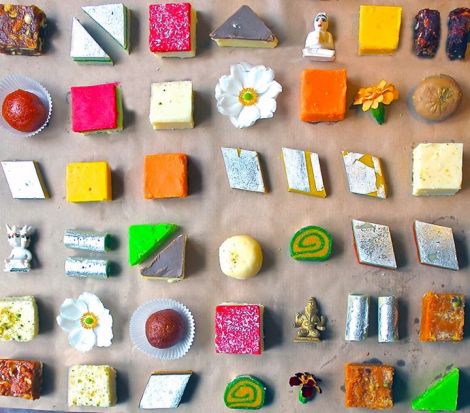
Rasgulla. Balushahi. Rajbhog. Jalebi. Gulab jamun. Halwa. Barfi. Malpua. Ladycanny. Chum chum. Kalakand. Laddoo. Imarti. Pinni. Mohanthal. Sandesh. Pera… Even the names are enough to send me into a sugar-fuelled revelry. The draw of the old fashioned ‘by the quarter’ sweetshops on every corner bear nothing of the lure of the Indian mithai wallah – whose counters are a haphazard rainbow at the end of which lies the ultimate pot of gold- a selection box, size large.
Yet this wonderful and endlessly perplexing cornucopia is often dismissed as far too rich and sickly, despite our collective national sweet tooth. An acute fondness for sticky toffee pudding and the peculiar thixotropy of golden syrup should render us Brits regular customers at the local Indian sweetmart. But it remains an untapped goldmine of slightly scary treasures bearing exotic foreign names. Fear of the unfamiliar has deprived millions of the fulsome pleasures of a succulent sandesh.
Let’s break it down. Desi ‘moiras’ – sweetmakers – are the Jedi masters when it comes to confectionary. Taking up residence over a vat of boiling milk, they’ll stir and stir for hours on end until it reduces to a solid mass – the manna otherwise known as khoya, or mawa. This is used as the basis for a galaxy of rich treats, most notably burfis- to paraphrase Amazon, ‘if you like fudge, you will give your eye teeth for khoya barfi’.
Broadly speaking, Indian sweets can be divided into seven categories according to ingredient base and cooking method. ‘Ball stages’ to gauge sugar syrups are replaced with ‘string theory’ – one, two- or three- ‘tar’ denoting the number of strands – and consequent thickness – formed when pulling the mixture between two fingers. There are dry sweets, wet sweets, creamy sweets, crunchy sweets, hard sweets, soft sweets, very sweet sweets and not-so-sweet sweets. You should probably try them all.
Whatever your sweet flavour persuasion, there’s an Indian equivalent. The honeycomb texture of a Crunchie bar is deliciously duplicated in mysore pak; Bengali chenna-based sweets, particularly sandesh, are for fans of cheesecake; and syrupy, juicy gulab jamun or fresh jalebi will appease the treacle sponge bunch. Peanut butter nutters beware any gram flour confection – or you will end up as round as the laddoos you can’t stop scoffing.
Devnaa is a company after my own ‘heading-for-a-heart-attack’ heart, keen to spread the sweet lovin’ to the uninitiated. Aside from the odd chocolate burfi, most sweetmarts have kept it old skool; dishing out delicacies developed thousands of years back and remaining true to their recipe roots. Not so these progressive chaps – who decided that covert methods were the way forward when it comes to converting the masses. Fusing chocolates presented in the traditional pretty British selection box manner with Indian-inspired fillings resulted in a saccharine-soaked, happy car-crash of taste.

The bright colours of the sweetmart are echoed in Devnaa’s pleasingly gaudy packaging. Inside, innocent rows of dark, milk and white chocolates nestle neatly in paper cases. These could be any old granny-pleasing geranium creams. BUT! Take a look at the menu- chai-infused caramels; pistachio burfi wrapped in bitter chocolate; cardamom-heady pralines. Everything works, and works spendidly, pleasing not only granny but the whole family.
It’s a canny strategy, and one which can only serve to widen the remit of the typical British sweet palate. Cornish fudge, Cadbury’s Dairy Milk and creamy caramels have always warmed the cockles of the Britisher’s heart. But there’s surely growing appetite, too, for kaju, kheer and kalakand. Devnaa have come up with a solution allowing everyone to have their confectionary and eat it too. For that, they deserve nothing short of the sweetest praise. And to be sent my lastest dentist’s bill.
- Devnaa chocolates are available online from www.devnaa.com
- Follow @devnaa on Twitter for the latest news and offers.
- Quince halwa image courtesy of Meena (@chai_lounge), host of the Chai Lounge supperclub in Edinburgh.
- Main image – Delhish


Pingback: A happy 2013 reflection and a Happy New Year 2014! | The Spice Scribe·
Pingback: Aping around at the Spice Monkey cookery school | The Spice Scribe·
Pingback: Fall in love with a Valentine’s Day celebration ‘choc’ full of Indian spice | The Spice Scribe·
Pingback: The palaver, the fun and the Holi post: Celebrate the Indian festival in the UK | The Spice Scribe·
Pingback: Valentine’s Day ‘choc’ full of Indian spice | Culinary Adventures of The Cocoa Nut·
Pingback: Indian culinary ‘red herrings’ – An introduction to some deceptively-named foods | The Spice Scribe·
Pingback: Indian pop-ups, events & restaurants Springing up this season | The Spice Scribe·
Pingback: The Challenge of Combining Chocolate & Curry for Find Your Feet | The Spice Scribe·
Pingback: Recipe: The ‘Bombay Bad Boy’ chocolate cheesecake | Culinary Adventures of The Cocoa Nut·
Pingback: Relishing Rajasthani food at Greenhill Kitchen’s ‘Rasovara’ pop-up | The Spice Scribe·
Pingback: Indian-inspired chocolate from Devnaa | Culinary Adventures of The Cocoa Nut·
Pingback: The Cinnamon Club cooks up Curry For Change | The Spice Scribe·
Pingback: Tony Singh – the ‘Tasty’-est Indian chef there ever was? | Culinary Adventures of The Spice Scribe·
Pingback: So Hot They’re Cool:Icy Indian recipes,Part 2 | Culinary Adventures of The Spice Scribe·
Pingback: Checking out some Great Taste Award-ed chocolate | Culinary Adventures of The Cocoa Nut·
Pingback: Discussing Dishoom with founder-walla Shamil Thakrar | Culinary Adventures of The Spice Scribe·
Pingback: Hi, chai! Devnaa does afternoon tea, Indian-style | Culinary Adventures of The Spice Scribe·